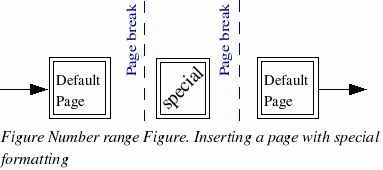Manual page breaks
The Next Style property is enough for projects with straightforward pagination requirements (for example, reports, letterheads, and small books). But more complex projects require more control over page styles. Manual page breaks provide this control.
The idea is simple: you break a sequence of page styles and start a new sequence. To insert a page break, choose Insert > Manual Break and choose Page break. This section illustrates two scenarios where page breaks are useful.
Example: Chapters
You are writing a book that is divided into chapters. Each chapter starts with a page style called New Chapter. The following pages use theDefault page style. At the end of the chapter, we return to New Chapter for the next chapter.
OOo doesn’t have a New Chapter style, so you must create a custom style (see page 147). Let’s suppose that you already have the page styles with the following properties:
-
-
|
Page style
|
Next Style
|
|
New Chapter
|
Default
|
|
Default
|
Default
|
This can be seen visually in the flowchart in Figure 176, but where the New Chapter style replaces the First Page style.
At some point, you will want to start a new chapter. Follow these steps:
-
Put the cursor at the end of the chapter, on a blank line of its own.
-
Choose Insert > Manual Break. The Insert Break dialog box appears.
-
Under Type, choose Page break and under Style, select New Chapter.

Figure 178 illustrates the flow of page styles when using page breaks.

Example: Inserting a page with special formatting
Sometimes you may need to insert a page with special formatting. For example, a landscape page or a page with more columns. This can also be done with page breaks. Suppose that the current page has the Default page style.
-
Choose Insert > Manual Break.
-
Select the page style (say, Special Page) in the Insert Break dialog box.
-
Fill in the contents for this page. Then insert another page break.
-
Then select Default again. The pagination continues on as normal, except that one page has been replaced by a different page style.
This concept is illustrated in Figure 179.

